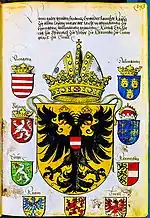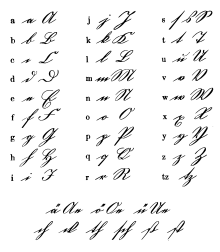Great Officers of State
Government in medieval monarchies generally comprised the king's companions, later becoming the Royal Household, from which the officers of state arose, initially having household and government duties. Later some of these officers became two: one serving state and one serving household. They were superseded by new officers, or were absorbed by existing officers. Many of the officers became hereditary and thus removed from practical operation of either the state or the household.[1]
Especially in the Norman kingdoms these offices will have common characteristics. In the United Kingdom, the Great Officers of State are traditional ministers of The Crown who either inherit their positions or are appointed to exercise certain largely ceremonial functions or to operate as members of the government.[2] Separate Great Officers of State exist for England and for Scotland, as well as formerly for Ireland and Sicily. Many of the Great Officers became largely ceremonial because historically they were so influential that their powers had to be resumed by The Crown or dissipated.
England
France
Holy Roman Empire



Princes elector held a "High Office of the Empire" (Reichserzämter) analogous to a modern Cabinet office and were members of the ceremonial Imperial Household. The three spiritual electors were Arch-Chancellors (German: Erzkanzler, Latin: Archicancellarius): the Archbishop of Mainz was Arch-Chancellor of Germany, the Archbishop of Cologne was Arch-Chancellor of Italy, and the Archbishop of Trier was Arch-Chancellor of Burgundy. The six remaining were secular electors, who were granted augmentations to their arms reflecting their position in the Household. These augments were displayed either as an inset badge, as in the case of the Arch Steward, Treasurer, and Chamberlain—or dexter, as in the case of the Arch Marshal and Arch Bannerbearer. Or, as in the case of the Arch Cupbearer, the augment was integrated into the escutcheon, held in the royal Bohemian lion's right paw.
| Augmentation | Imperial office | German | Latin | Elector |
|---|---|---|---|---|
| Arch-Cupbearer | Erzmundschenk | Archipincerna | King of Bohemia | |
| Arch-Steward (or Arch-Seneschal) | Erztruchseß | Archidapifer | Elector Palatine to 1623 | |
| Elector of Bavaria, 1623–1706 | ||||
| Elector Palatine, 1706–1714 | ||||
| Elector of Bavaria, 1714–1806 | ||||
| Arch-Treasurer | Erzschatzmeister | Archithesaurarius | Elector Palatine, 1648–1706 | |
| Elector of Hanover, 1710–1714 | ||||
| Elector Palatine, 1714–1777 | ||||
| Elector of Hanover, 1777–1814 | ||||
| Arch-Marshal | Erzmarschall | Archimarescallus | Elector of Saxony | |
| Arch-Chamberlain | Erzkämmerer | Archicamerarius | Elector of Brandenburg | |
| Arch-Bannerbearer | Erzbannerträger | Archivexillarius | Elector of Württemberg[3] |
Hungary
In the Kingdom of Hungary the Great Officers of State were non-hereditary court officials originally appointed by the king, later some of them were elected by the Diet. They were also called the barons of the kingdom (Hungarian: országbárók, országnagyok) and lords banneret because they were obliged to lead their own Banderium (military unit) under their own banner in times of war. The offices gradually got separated from the role they originally fulfilled and their deputies took over the responsibilities.
| Position | officer | Hungarian | Latin |
|---|---|---|---|
| 1 | Palatine | nádor | palatinus, comes palatinus |
| 2 | Voivode of Transylvania | erdélyi vajda | voivoda Transsylvaniae |
| 3 | Judge royal | országbíró | judex curiae regiae |
| 4 | Ban of Croatia, Ban of Macsó, Ban of Szörény | horvát bán, macsói bán, szörényi bán | banus totius Sclavoniae |
| 5 | Master of the treasury | tárnokmester | magister tavarnicorum, magister tavernocorum regalium or summus camerarius |
| 6 | Master of the doorkeepers | Ajtónállómester | Janitorum regalium magister |
| 7 | Master of the stewards | asztalnokmester | dapiferorum regalium magister |
| 8 | Master of the cupbearers | pohárnokmester | pincernarum regalium magister |
| 9 | Master of the horse | lovászmester | agasonum regalium magister |
| 10 | Ispán of Pozsony County and Temes County | pozsonyi és temesi ispán | comes Posoniensis and comes Temesiensis |
| 11 | Royal treasurer | kincstartó | summus thesaurarius |
| 12 | Ispán of the Székelys | székelyek ispánja | comes Siculorum |
| 13 | Privy Chancellor | titkos kancellár | cancellarius aulicus |
Ireland
Naples
During the Vespers War, the Angevins were expelled from the island of Sicily but remained to reign in the continental territories of the kingdom thus forming the so-called kingdom of Naples, but also claiming the throne of Sicily; this explains why the official name of the kingdom of Naples was the kingdom of Sicily. When the Angevins kings settled in Naples they recreated the seven offices of the kingdom
Poland
The following dignitaries were permanent members of the Council in the Crown of the Kingdom of Poland:
- Great Chancellor of the Crown
- Great Marshal of the Crown
- Great Treasurer of the Crown
Scotland
Sicily
History
In the Kingdom of Sicily, which existed from 1130 to 1816, the Great Officers were officials of the Crown who inherited an office or were appointed to perform some mainly ceremonial functions or to act as members of the government. In particular, it was a norman king, Roger II, who once he became King of Sicily and conquered the territories of Southern Italy was concerned with organizing the Kingdom politically. For this reason, in 1140 King Roger convened a Parliament in Palermo where the seven most important offices of the Kingdom of Sicily were established, to which the title of archons was given.[4][5][6]
The system has notable similarities with the English one, being both derived from Norman rulers, in which four of them had a certain correspondence with the officers of the court of the Franks, where there was a senescalk, a marchäl, a kämmerer, a kanzlèr; later reverted with the Great Officers of the Kingdom of France.[7]
With the pragmatic of November 6, 1569 on the reforms of the Courts, three Great Offices of the Kingdom are made the prerogative of the judiciary: the Great Chancellor by President of the Tribunal of the Sacred Royal Conscience; the Great Justiciar, whose functions had already been absorbed by President of the Tribunal of the Royal grand Court; and the Great Chamberlain by the President of the Tribunal of Royal Patrimony.[8]
Officers of State
The Great Officers of State of the former Kingdom of Sicily, consisting of Sicily and Malta, were:
| Position | Officer | First and last holder[9] | Notes |
|---|---|---|---|
| 1 | Great Constable | - Robert of Hauteville
- Fabrizio Pignatelli d’Aragona, duke of Monteleone |
The Gran Conestabile was the commander of the army, in charge of judging the cases of military relevance, he was the highest[10] officer of the Kingdom |
| 2 | Great Admiral | - George of Antioch
- Diego Pignatelli, prince of Castelvetrano |
The Grande Ammiraglio dit amiratus amiratorum was the commander of the Kingdom of Sicily’s Navy. For a short time the title of granted with that of Count of Malta. This office was by far the most influential as the Sicilian navy was the most powerful Christian fleet during the Middle Ages in the Mediterranean |
| 3 | Great Chancellor | - Guarin
- marquess Antonio Ardizzone |
The Gran Cancelliere kept and affixed the Seal of the Kingdom of Sicily. His functions could be compared to those of the Prime Minister and the Minister of Foreign Affairs. During the Hauteville’s dynasty most of the chancellors were ecclesiastics. From 1569 until 1816 the office was held ex officio by the President of the Tribunal of the Sacred Royal Conscience, the high-instance court |
| 4 | Great Justiciar | - Robert of Rocca
- Giovanni Battista Asmundo e Paternò |
The Gran Giustiziere was the most senior judge and the head of the judiciary. Peter II made the office hereditary first to the Count of Mistretta and second to the Count of Agosta until the reform of 1569. From that date until 1816 the office was held ex officio by the President of the Tribunal of the Royal grand Court, the civil court |
| 5 | Great Chamberlain | - Richard of Mandra, Count of Molise
- knight Michele Perremuto |
The Gran Camerario had the role of treasurer, in fact he watched over the administration of public expenditure. The office soon became hereditary as prerogative of the Count of Geraci. From 1569 until 1816 the office was held ex officio by the President of the Tribunal of Royal Patrimony |
| 6 | Great Prothonotary | - Matthew of Ajello
- Alfonso Ruiz (?) |
The Gran Protonotaro was the notary of the Crown and secretary of the Sacred Royal Council and of the Parliament, the prothonotary had extensive functions in administrative matters and was the head of all notaries of the Kingdom. He had also particular skills in matters of feudal ceremony and investitures. The office was also a registering body for royal acts similar to the chancery |
| 7 | Great Seneschal | - Richard of Hauteville
- Prince Francesco Statella, marquess of Spaccaforno |
The Gran Siniscalco supervised the Royal Palace, providing the King and the court with provisions, supervising the royal forests, and hunting reserves. He was the Judge of the Royal House and its subordinate officers. In 1296 the office soon became hereditary as prerogative of the Count of Modica and it was later inherited by Marquess of Spaccaforno |
Sweden
See also
- Great Offices of State
- Royal Households of the United Kingdom
- Kingdom of England
- Great Officers of the Crown of France
- Kingdom of France
- Holy Roman Empire
- Great Officers of State of Ireland
- Kingdom of Ireland
- Kingdom of Poland
- Kingdom of Scotland
- Kingdom of Sicily
- Great Officers of Sweden
- Kingdom of Sweden
References
- Chisholm, Hugh, ed. (1911). . Encyclopædia Britannica. Vol. 13 (11th ed.). Cambridge University Press. pp. 813–814.
- Chisholm, Hugh, ed. (1911). . Encyclopædia Britannica. Vol. 25 (11th ed.). Cambridge University Press. p. 801. This cites:
- “The Holy Roman Empire,” Heraldica
- Scinà, Domenico (1859). Prospetto della storia letteraria di Sicilia nel secolo decimottavo (in Italian).
- Palmeri, Niccolò (1848). Saggio storico e politico sulla Costituzione del Regno di Sicilia infino al 1816: con un'appendice sulla rivoluzione del 1820 (in Italian).
- Morelli, Serena (5 April 2016). Les grands officiers dans les territoires angevins - I grandi ufficiali nei territori angioini. Publications de l’École française de Rome. ISBN 978-2-7283-1207-8. Retrieved 3 January 2021.
- Palermo, Archivio di Stato di; stato, Palermo (Italy) Archivio di (1950). R. Cancelleria di Sicilia: inventario sommario (sec XIII-XIX) (in Italian). editore non identificato.
- Blaquiere, Edward (1813). Letters from the Mediterranean; containing a civil and political account of Sicily, Tripoly, Tunis, and Malta: with biographical sketches, anecdotes and observations, illustrative of the present state of those countries, and their relative situation with respect to the British empire. Henry Colburn, English and Foreign Public Library, Conduit-Street, Hanover-Square; and sold.
- Marrone, Antonio. I titolari degli uffici centrali del Regno di Sicilia dal 1282 al 1390 (PDF).
- Giuseppe Mandalà – Marcello Moscone. Tra Latini, Greci e 'arabici': ricerche su scrittura e cultura a Palermo fra XII e XIII secolo.